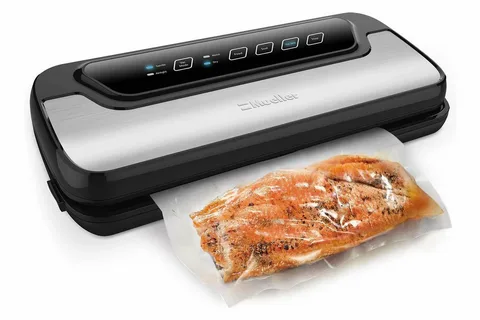Vacuum Sealer Machine comes in various types, each suited for different applications. Handheld models are portable and ideal for light and everyday use. External vacuum sealers work well for medium-duty tasks, offering flexibility with various bag sizes. Chamber vacuum sealers, typically found in professional kitchens, provide the highest level of performance, efficiently sealing liquids and bulkier items. Each type has unique advantages, catering to specific needs ranging from casual home use to commercial food preservation.
The Importance of Suction Power in Vacuum Packing Machine
Suction power is a pivotal element in the functionality of a vacuum packing machine. A machine with high suction power effectively removes air from the packaging, crucial for maintaining food quality and extending shelf life. It is especially beneficial for sealing various food items, including delicate or moisture-rich foods that require precise control to avoid crushing or damage.
Adjustable suction settings add to the versatility, allowing the machine to efficiently handle a broader range of packaging needs. High suction power also contributes to faster sealing times, increasing overall productivity in both home and commercial kitchens. Additionally, a machine with strong suction capabilities can better accommodate various bag sizes and types, ensuring a secure and reliable seal each time. Thus, suction power should be a key consideration when evaluating a vacuum packing machine, as it directly influences the machine’s effectiveness and versatility.
Sealer Machine Material Quality
The construction material of a sealer machine is a key factor influencing its performance and durability:
High-Grade Stainless Steel
Machines crafted from stainless steel are highly sought for their resilience and longevity. Stainless steel resists corrosion, ensuring the machine remains operational over time, even in frequently used environments. This durability makes it suitable for both home kitchens and commercial settings.
Enhanced Efficiency
The use of premium materials helps maintain the machine’s efficiency, ensuring optimal performance even during extended operation. Quality materials also allow for smoother, more consistent sealing, which is crucial for achieving airtight seals on various packaging types.
Better Sealing Mechanisms
Machines constructed with top-quality materials tend to feature advanced sealing technologies that always deliver reliable, tight seals. This ensures that the contents of the package remain preserved for longer periods, enhancing both storage and transportation.
Refined Design and Appearance
Besides durability, high-quality materials often result in machines with sleek, modern designs. Their professional appearance adds sophistication, particularly in commercial or food service environments.
Ease of Maintenance
Machines made from high-quality materials are typically easier to clean and maintain. Stainless steel, for instance, is resistant to stains and odours, making upkeep more straightforward and less time-consuming.
In summary, opting for a sealer machine made from high-quality materials ensures long-lasting performance, better efficiency, ease of maintenance, and a professional look—making it a worthwhile investment for personal and business needs.
User-Friendly Design Features in Vacuum Pack Sealer Machine
User-friendly design features are essential to ensuring smooth operation in a vacuum pack sealer machine. Clear and easily accessible control panels allow users to navigate different settings without confusion. Simple button operations enable quick adjustments, making the process more efficient. Furthermore, including detachable and dishwasher-safe parts facilitates cleaning and maintenance, adding to the machine’s practicality.
Portability and compactness are also significant design considerations. A machine that is easy to store and transport can be a game-changer in kitchens with limited space. Lightweight models are particularly advantageous for those who need to move the machine frequently. Moreover, a vacuum pack sealer with a transparent lid offers the added benefit of monitoring the sealing process, allowing for timely adjustments.
The design of the sealing area itself can greatly impact usability. A spacious sealing chamber can accommodate various bag sizes, while built-in bag cutters and storage compartments streamline the process. Ergonomically designed handles and non-slip bases further increase ease of use, ensuring the machine remains stable during operation. User-friendly features make vacuum pack sealers more efficient and accessible to a wider range of users.
Sealing Versatility of a Vacuum Machine
A vacuum machine’s sealing versatility is crucial for its overall utility in various settings. Multiple sealing settings allow it to handle a wide range of items, including both dry goods and liquids. This flexibility is particularly important for preserving different textures, from delicate herbs to robust cuts of meat. Compatibility with various bag types, such as rolls, pouches, and even jars, enhances the machine’s functionality. This adaptability means users can choose the most appropriate packaging method for each food item.
Advanced models often include specialised settings for different food categories, ensuring optimal sealing conditions for each type. For example, gentle modes prevent crushing delicate items like bread, while strong settings are ideal for more durable goods. Some machines also offer a double-sealing option, providing extra security for long-term storage or more volatile items.
Furthermore, the machine’s versatility is enhanced by its ability to handle different bag materials and sizes without compromising the quality of the seal. This is particularly beneficial for those who preserve a wide array of items, from small snacks to bulk quantities. Therefore, a versatile vacuum machine is an invaluable tool in both domestic and commercial kitchens, adapting seamlessly to various packaging needs.
Maintenance Requirements for Vacuum Machine
Regular maintenance is crucial for ensuring a vacuum machine’s optimal performance and longevity. Many models are designed with ease of maintenance in mind, incorporating components that can be easily detached and are often dishwasher-safe. This design feature streamlines the cleaning process, reducing the time and effort required to maintain the machine in peak condition.
Key components, such as the sealing bar and gaskets, should be periodically inspected and cleaned to prevent the buildup of food residues, which can interfere with the sealing quality. Over time, this buildup can cause the seals to weaken or become inefficient, potentially compromising the machine’s effectiveness.
Some models include built-in maintenance indicators, which alert users when certain parts need attention. For example, replacing or cleaning the filters regularly is essential to ensure the machine maintains its suction power. Inspectingacuum pump should be inspected for signs of wear and tear, especially in high-use commercial environments. Keeping the pump in good condition is essential for maintaining the machine’s vacuuming efficiency.
As outlined by the manufacturer’s guidelines, lubricating moving parts can significantly enhance the machine’s lifespan by reducing friction and wear. In addition, keeping the machine’s exterior clean and free from spills helps maintain its appearance and prevents potential operational issues. Finally, proper storage in a dry, dust-free environment protects the machine from damage and extends its usability. Regular care and attention to these maintenance tasks are key to keeping the vacuum machine running efficiently for years.
Energy Efficiency Considerations in Sealer Vacuum Packaging Machine
Energy efficiency is a significant factor in modern Sealer Vacuum Packaging Machine. Machines designed with energy conservation can operate effectively while consuming less power. Many advanced models incorporate automatic shut-off features, which help reduce energy wastage by turning the machine off when it is inactive.
This reduces electricity costs and adds an extra layer of safety by preventing overheating. Energy-efficient machines are often designed to perform optimally with minimal energy input, ensuring that food preservation is not compromised. This is particularly important in commercial kitchens, where machines may be used continuously throughout the day.
By choosing a machine with a high energy efficiency rating, businesses and households can contribute to environmental sustainability whilst still benefiting from reliable and effective vacuum sealing. Opting for models that offer eco-friendly operation aligns with broader efforts to reduce carbon footprints and promotes a more sustainable approach to food preservation.
Conclusion
Choosing a high-quality vacuum sealer machine involves considering factors such as suction power, material quality, user-friendly design, sealing versatility, maintenance requirements, and energy efficiency. Each element ensures the machine’s performance, durability, and overall value. Selecting the right machine can significantly enhance food preservation, making it an invaluable tool in domestic and commercial kitchens. By focusing on these features, one can make an informed decision, ensuring the vacuum sealer meets specific needs and stands the test of time.
FAQS
What types of vacuum sealer machines are available?
Vacuum Sealer Machine is classified into handheld, external, and chamber models. Handheld versions are compact and suitable for light-duty tasks. External models offer more flexibility and can handle medium-duty operations. Chamber models are designed for professional use, providing high performance for sealing liquids and bulkier items.
Why is suction power important in a vacuum machine?
Suction power is crucial as it determines the machine’s ability to effectively remove air from the packaging. High suction power helps maintain food quality and extend shelf life. Adjustable suction settings allow for better control, especially when sealing delicate or moisture-rich foods.
How does material quality influence vacuum sealer performance?
The quality of materials used in a vacuum machine significantly impacts its durability and reliability. Machines constructed from high-grade stainless steel are particularly valued for their resistance to corrosion and physical damage, ensuring long-term performance. Superior materials also contribute to better sealing mechanisms and overall efficiency.
What design features make a vacuum machine user-friendly?
Clear control panels, simple button operations, and dishwasher-safe detachable parts are user-friendly design features in vacuum machines. Portability and compactness are also essential, making the machine easier to store and transport. Transparent lids and spacious sealing chambers further enhance usability.
How does energy efficiency benefit vacuum sealing?
Energy-efficient vacuum sealing machines are designed to operate effectively while consuming less power. Features such as automatic shut-off help reduce energy wastage and prevent overheating. These machines provide reliable performance with minimal energy input, making them ideal for commercial and domestic use and supporting environmental sustainability.



